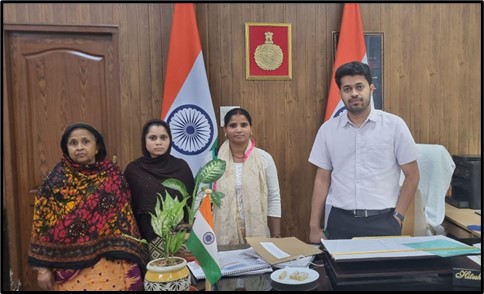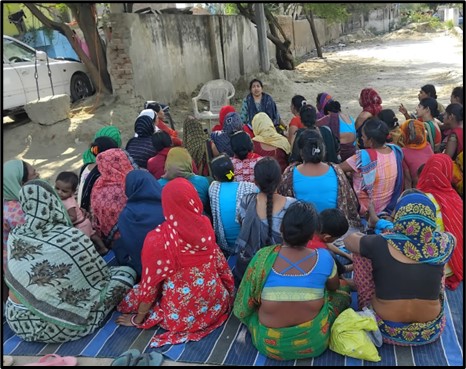The word "empowerment” is a go-to word for organisations working on women's issues. It is often incorporated in project proposals as an end goal, to be achieved over a period of time. However, given the nature of funding towards women’s issues, which in many cases tends to be short term (less than a year), the frequent use of the term calls for its deeper analysis.
What is the meaning of the terms “empowerment” and “women’s empowerment”? And what is the role of power and the forces that help sustain its manifestations in the larger context of society in limiting empowerment? As I explore below, I think that community mobilisation is a prerequisite to challenge the existing ideologies and institutions which perpetuate and sustain the power imbalance in favour of a male dominated societal order.
Goal 5 of the Sustainable Development Goals (SDGs) talks about achieving gender equality and the empowerment of all women and girls by 2030. According to a report by the United Nations, the world is not on track to achieve gender equality and empowerment by 2030. Of the many causes attributed to it, a narrow understanding of women's empowerment, which focuses on individuals rather than the structures that sustain and perpetuate dis-empowerment, is, I believe, one of the critical reasons responsible for the goal being off the track.
The term empowerment subsumes "power" without which it will make no sense as a process and as an outcome of the process. The term “power” refers to the access and control over physical, human, intellectual and financial resources. The control over one or more of these resources becomes a source of individual and social power. The greater the access and control over resources, greater is the degree to which power is exercised both individually and at a societal level. For example, a moneylender who has greater access and control over land, labour and financial resources, exercises a greater control over the decisions of the village through the Panchayat. On the other hand, a Dalit woman who is landless, indebted and illiterate is often left out of the decision making process by the Panchayat.
The power imbalance between a moneylender and a Dalit woman in initial phases might be established through the use of force. But, over time, the unequal power division is maintained under the guise of certain ideologies. In the current example, it is the caste system along with its institutions which has helped sustain and perpetuate this inequality.
In the case of women domestic workers, this power imbalance is maintained by the employer, due to the informal nature of employment and due to the thinking that domestic work is an extension of their traditional gender roles as home managers. Hence, it is patriarchy which, through its complex structures of beliefs, values, attitudes and way of perceiving social reality, has sustained unequal power relations. This has led to formation of institutions - family, education, marriage, divorce, property rights, judicial system and governments - which are male dominated and which exclude women from decision making positions. The interplay of power and patriarchy manifests itself in unequal gender relations, wherein women have less or no access and control over resources and decision making, including the freedom to make decisions for oneself.
Women's empowerment, in such a scenario, then, can be defined as the process and the outcome of the process by which women gain resources and challenge the ideology of patriarchy and gender-based discrimination being sustained and perpetuated by various institutions of the society. When emphasised as a process, women's empowerment should begin from consciousness raising to the equitable distribution of resources through laws, policies, and societal order in favour of women. On the other hand, when emphasised as an outcome of the process, women's empowerment ought to lead to a societal order wherein both the condition (material state) and position (socio-economic status) of women should improve relatively and absolutely.
For the process of empowerment to be sustainable, it is critical that women come together, because when challenging an entire system or ideology, the power of a group is always greater than the power of individuals. The history of the women's rights movement is full of such instances where women rights groups have come together to push for an equal agenda for women. One such instance is the Women’s Day Off that took place in Iceland on 24 October 1975, when women all over the country stopped working to protest the wage gap and their status compared to men. In India, it was only after a persistent advocacy from women’s rights groups that the Sexual Harassment of Women and Workplace (Prevention, Prohibition and Redressal) Act, 2013 (PoSH Act) was passed by the parliament of the country.
Community mobilisation, then, gains importance as a step towards women’s empowerment. It is pertinent to emphasise here that the term “community mobilisation” is sometimes used very narrowly to refer to mobilising women for certain activities or events. However, community mobilisation in its entirety refers to a process wherein a community comes together to initiate dialogue around issues which affect them and take action collectively to improve the overall well being of the community. Community mobilisation, then, can be seen as a powerful tool in the empowerment of women and as the means to address violation of their rights.
The Martha Farrell Foundation, which works in Delhi and Haryana with women and children on the issue of gender-based violence, has been mobilising women around the issue of workplace safety since its inception in 2015. Under its #MainBhi programme, the organisation has mobilised women from various communities of Delhi to push for the effective implementation of the PoSH Act. The impact of these mobilisation efforts can be seen on ground today.
After three years of the Ending Sexual Harassment: Making Institutions Accountable towards Women Workers in the Informal Sector project (2021-2024), under the #MainBhi programme, more than 100 women leaders, known as “Pehelkars” (named by women themselves, to signify those who initiate actions) have been successful in building solidarity among women domestic workers, supporting them to take action against cases of violence. In one such instance, a group of 30 women from Jasola Vihar fought and negotiated with the police to rescue two domestic workers from a violent employee, where the domestic workers were made to work without food and water for more than a week. In another instance, more than 500 women domestic workers from Delhi came together and demanded effective implementation of the PoSH Act through formation of functional Local Committees (LCs) from the District Magistrates of six districts of Delhi.

Women domestic workers with the Additional District Collector of Gurugram to submit their memorandum of demands
While there was a concerted effort by the women domestic workers demanding functional LCs, efforts were also being put in to bring the LCs and women domestic workers together on a common platform. The efforts gave way to a state level consultation, where, for the first time ever, women domestic workers and LC members came together to deliberate the challenges faced by them and recommend steps to ensure the meaningful implementation of the PoSH Act in all districts of Delhi. The consultation brought the LC members and women domestic workers together on multiple occasions with women from North Delhi and South-West Delhi holding meetings with LC members to deliberate on making LCs accessible to the women. For wider dissemination of information, the women domestic workers from North, South, South-East and South-West districts have put out banners in their communities with details of the LC members. One of the domestic workers associated with the Martha Farrell Foundation once said “Bhanwari Devi’s struggle has inspired us and given us the belief that if she can overcome challenges, so can we.”

Women domestic workers interacting with Local Committee member from North Delhi district
Empowerment as a process can be enabled (and not said to have been done) over a period of time. There are both internal and external forces acting as enablers (or hindrances) to this process. While the external forces include rights-based entitlements provided by the state, welfare projects/programmes run by civil society organisations, and the various institutions in the form of laws, policies, family and marriage, internal forces include self-consciousness and the capacity to question and act against the unequal power structures. To enable the process of empowerment, both these forces need to work simultaneously, with one supporting the other.
Although the #MainBhi programme, through community mobilisation, has enabled the women domestic workers to raise self-awareness about the issue of sexual harassment and question the non-existence of LCs in Delhi, there is a lot that still needs to be done to address the root causes of inequality and the structural barriers that continue to hold women back. For this to happen, it is high time now that we understand empowerment in its totality, and incorporate strategies which improve both the condition and the position of women in the society, in the absence of which, as warned by the United Nations, it will take 300 years to achieve full gender equality at the current rate of progress.